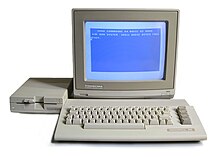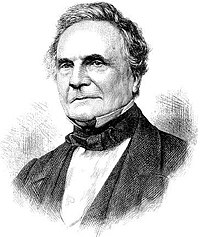Introduction to Computers/History
Course Navigation
| << Previous - What is a computer | Next - Computer types >> |
|---|
History of the computer. The computer is a programmable electronic device that can store, retrieve, and process data. It was designed in the 19th century.
Recommended Reading
[edit | edit source]Notable History
[edit | edit source]
Computers were initially large machines that could fill entire rooms. Some were operated using large vacuum tubes that formed the basis of today's transistors. In order to operate such machines, punch cards were used as the input. Fundamentally, this is still the same way that computers operate today with binary code. One of the first such examples of a computer that operated based on punch cards was the Jacquard Loom. In 1833, Charles Babbage invented his difference engine, an early calculator. Although it was never fully created, the ideas in its design formed the theoretical foundation for later computers. He succeeded his design of the difference engine with the more complicated the analytical engine. This is the first known instance of someone conceptualizing and attempting to design a machine which could store and process numbers. Regrettably, this engine never saw completion either, however the conceptual framework of the machine was also incredibly influential.
Over time computers became more and more powerful, with the introduction of the ubiquitous microprocessor driving forward development. Gordon Moore, one of the co-founders of Intel, invented Moores law, which predicted that the number of transistors that could be placed on an integrated circuit inexpensively doubled every 2 years. This law has held true to a certain degree, and it can be seen in motion every day with the introduction of more and more powerful microprocessors and larger hard drives and memory modules.
Notable Computers
[edit | edit source]Here are some computers that came and went in the history of computing. Some modern examples are also shown here.
Z1
[edit | edit source]
The Z1 was a mechanical computer designed by Konrad Zuse in 1935 and first built in 1936. It was a binary electrically-driven mechanical calculator with limited programmability, reading instructions from punched tape.
ENIAC
[edit | edit source]
A behemoth of a machine weighing 27 tonnes, ENIAC stood for Electrical Numerical Integrator and Computer. Originally planned for use in calculating artillery firing tables, on completion in 1946 its first tasks were to perform calculations for hydrogen bomb design. The ENIAC used thousands of vacuum tubes and a punch card mechanism. Working out the programming on paper took weeks, and performing the necessary wiring took days. The ENIAC saw service until October 2, 1955.
Altair 8800
[edit | edit source]A microcomputer design from 1975, the Altair is considered to have started the personal computer revolution. It was the target of Microsoft's first product: a programming language called Altair Basic. The computer was sold as a kit requiring assembly by the user, although pre-assembled kits could be bought for a higher price. The Altair defied sales forecasts by selling thousands instead of hundreds to computer hobbyists, accelerating a growing hacker culture.
Commodore 64
[edit | edit source]
An 8 bit computer introduced in January 1982, the Commodore 64 rose to become the best selling personal computer of all time. Office productivity tools such as word processors, spreadsheets and databases were available, but due to its advanced graphics and audio systems, along with the inclusion of a cartridge slot, the Commodore was seen as a gaming device rather than a productivity tool, with over 20,000 games released, and even game development environments such as the Shoot'Em-Up Construction Kit.
Macintosh
[edit | edit source]First introduced by Apple in 1984, the Macintosh was the first popular computer to use a mouse and graphical user interface (GUI) rather than a command line interface, and was initially used primarily as a desktop publishing tool.
The Macintosh is famous for its 1984 advertisement, which can be viewed here.
IBM PC
[edit | edit source]The granddaddy of all current personal computers, the IBM PC was introduced in 1981. It was capable of running 3 different operating systems at launch, the most popular being PC DOS. Because of its success, many manufacturers were encouraged to create clones with the same feature set as the PC, which we use today as our computers.
Podcast
[edit | edit source]Check out this podcast for more information on the history of Computers.
https://www.stitcher.com/podcast/charles-edge/the-history-of-computing
The history of computers is a long one.
Images
[edit | edit source]| Search for History of computers on Wikipedia. |
Course Navigation
| << Previous - What is a computer | Next - Computer types >> |
|---|



